| shorebirding_trip_6_september_2014.pdf |
Below is a gallery of images from the shorebirding trip:
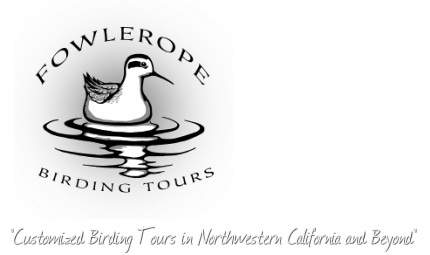
|
|
|
On September 6 I led a fall shorebirding tour, which fortuitously happened to be the same day as World Shorebirds Day! I put together a brief trip report that you can read here:
The next Fowlerope local day tour is this SUNDAY, 21 September, and will focus on finding vagrant landbirds in the well-known coastal migrant traps in the Humboldt Bay region. We will also chase any recently reported rarities that have been recently reported. You can easily sign up through paypal on my Local Day Tour page and find more information there for this and other upcoming trips. Below is a gallery of images from the shorebirding trip: Happy Fall Migration!! -- Rob
1 Comment
On Sunday, 16 February I was hired to do some serious target birding with UK birder, Ian Merrill. We were originally scheduled to go out Saturday the 15th but heavy rain and wind gave strong reason to reschedule for Sunday, which was forecasted to be overall clear and sunny with no rain. It was a perfect plan as Sunday was a perfect "bluebird" type day with mostly sunny skies, little wind, and perfect temperatures.
I met Ian at 0530 since he had expressed interest in looking for some owls like BARN (he was interested in seeing the North American version), WESTERN SCREECH, and lastly--but most importantly--SPOTTED. We met up at my traditional meeting spot in north Arcata and took a quick trip through the Arcata Bottoms to look for Barn Owls, which we found one and got nice looks on the "V Street Loop," one of the most popular birding locations in the Arcata Bottoms. We then headed to a location in Arcata where I've had Screech-Owl and tried various call types but couldn't coax one out but did have a pair of GREAT HORNED OWLS duetting in the background while trying for it. We also dipped on SPOTTED in the nearest location where I know they occur. No calls were played for this species as this location as it does get some birding pressure since it is the closest known location where Spotted is found. We did have a "light" dawn chorus at the Spotted location with some VARIED THRUSHES doing some brief 1/2 songs and AMERICAN ROBINS flying overhead from their night roost. After picking up Ian's wife Vic from the Best Western in Arcata we headed east to Maple Creek Rd. where RUFFED GROUSE has been seen lately. We drove the road to about 13 miles in and struck out on this round for the grouse and decided to move on to Blue Lake to look for a NORTHERN SHRIKE that was wintering along the Mad River and ranged over a mile along different areas along river so was difficult to find. To top it off this bird hadn't been reported since 25 January! Tough searching for the bird ensued, which we never found but we did enjoy the other birds that were seen along the way, like this immature (2nd year) BALD EAGLE below: 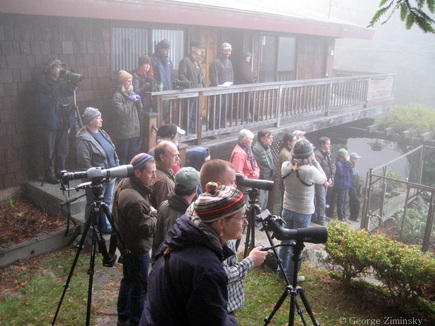 The full "Winter Rarities" group at the stakeout Summer Tanager in Arcata. The full "Winter Rarities" group at the stakeout Summer Tanager in Arcata. Well, another year has passed and gone and 2013 has ended. Here in Humboldt County, 2014 has kicked off with a bang as far as rare birds goes! Many rarities were found on the Arcata and Centerville to King Salmon Christmas Bird Counts and a couple have popped up in the New Year that weren't discovered beforehand. So, with my 4th annual Redwood Region Audubon ”Winter Rarities” field trip we had a lot of options to work on. This was how the day was planned out: 1) NORTHERN WATERTHRUSH at the Arcata Marsh. Every year I've led this trip we meet at the Arcata Marsh at 7:30 a.m. and the first rare bird we always try for to kick off the trip with is the Northern Waterthrush that winters at the Butcher Slough Log Pond. We also typically spend time walking around the Log Pond to look for other somewhat rare birds like SWAMP SPARROW, but we had bigger fish to fry (well....birds...you know what I'm talking about!) which leads us to rarity number 2 on the agenda... 2) SUMMER TANAGER. On Thursday evening (2 January) I was forwarded some photos of a bird coming to a feeder in Arcata that was identified as a possible Summer Tanager. According to the home owners hosting this bird it had been present since 26 December but had just been identified by some other friends of theirs that were familiar with this species. The bird WAS a Summer Tanager and Daryl Coldren and I got to visit the couple and secure access for other birders to come look for the bird the Friday before this trip (3 January.) After visiting the Summer Tanager stakeout we went out to Blue Lake for the next rarity stakeout for the day.... 3) LAWRENCE'S GOLDFINCH and 4) NORTHERN SHRIKE. A female Lawrence's Goldfinch was discovered by Paul Lohse at his farm out in Blue Lake near the end of December. A NORTHERN SHRIKE has also been present out here as of late and Daryl and I had it at Paul's farm Friday and Keith Slauson had refound the goldfinch before our arrival. Two good rarities in one location was too good to pass up so Paul's farm was to be our third location to visit for the day. Arcata Marsh for lunch. We didn't have any other rare birds to look at the Marsh but I thought the I Street parking lot would be good for our lunch break to add some year birds to the trip list with the local wintering FORSTER'S TERNS, plus roosting shorebirds at high tide and waterfowl at Klopp Lake and north Humboldt Bay. 5) HARRIS'S SPARROW. On the Arcata CBC I had found a Harris's Sparrow in my sector in Eureka, which was the next bird on our agenda. It's been a great fall/winter for Harris's Sparrow with 2 being found in the fall and then 2 were found on the Arcata CBC (Keith Slauson found one in McKinleyville, also) and another one was found in the Ferndale Bottoms before 2013 ended. 6) LOGGERHEAD SHRIKE. Since October of 2013 a Loggerhead Shrike had been present off of Quinn road and continued into 2014. This is the same exact location where we had refound a NORTHERN SHRIKE that was present here last fall/winter. Must be a great spot for shrikes! 7) CATTLE EGRET. A Cattle Egret, now a rarity in Northwestern California, had been present as of late on Goble Lane in the Ferndale Bottoms and was being consistently seen. 8) CRESTED CARACARA. This bird was found by Jeff Allen on the Centerville CBC and won the prize for one of the better rarities found on the local CBCs this winter. There hasn't been a caracara in Humboldt County since 2007 and, more than likely, this was the bird that had been long-present in Del Norte County to the north. This was probably going to be the hardest bird to refind as it can be ANYWHERE in the Ferndale Bottoms area/Eel River delta area. 9) SANDHILL CRANE. A juvenile Sandhill Crane was discovered around 18 December in the east Ferndale Bottoms and continued through the New Year and would probably be our “closer” for the day. Ok, So we had a game plan and lot's of potential birds for us to refind and certainly enough to fill the day up! Also, like I always tell the trip participants: even though we are focused on refinding stakeout rarities they are only the vehicle for getting us out birding and we make a point to enjoy every bird that we come across along our journey. The rarities are just means for the journey, not the end. So....how did we do you wonder? Let's get into it, shall we? 1) NORTHERN WATERTHRUSH: After the 25+ people signed in and I gave a brief explanation on the plan for the day we went to go find our first target. At the brown wall at the southeast corner of the Butcher Slough Log Pond at the Arcata Marsh, I briefly pished. About a minute later, the WATERTHRUSH started calling and came in close but stayed out of view. All trip participants heard the bird. More often than not you hear this waterthrush and it's rather difficult to see most of the time so we were all satisfied with a “heard only.” eBird list here. 2) SUMMER TANAGER: Since we had such a large group, I called the homeowners that were hosting the Summer Tanager and informed them how many people to expect, making sure it was still ok for us to visit them. IT WAS! We carpooled to the tanager house on California St. in Arcata and quietly gathered in their front yard to watch the black oil sunflower feeder the bird was frequenting. Within 10 minutes the bird came in, grabbed a sunflower seed from the feeder and quickly flew out of view. Everybody saw the bird but I suggested we stick around for 10 more minutes to see if it would come back. It did, and we got much better prolonged views of the bird. Satisfied, we thanked the homeowners and moved on to Paul Lohse's farm in Blue Lake for our next targets. eBird list here. Below is Gary Bloomfield's digiscoped video with photos he also took with his iPhone 5S. Check out that slow motion capability of the new 5s! 3 and 4) LAWRENCE'S GOLDFINCH AND NORTHERN SHRIKE. Paul's farm is adjacent to the famous “Blue Lake Cottonwoods” and though the Cottonwoods are a popular birding location--especially during spring migration--his farm is always worthy of a walk through and he welcomes birders throughout the year. Paul's farm is especially attractive to seed eaters, especially sparrows from fall through winter and has attracted many interesting species like Clay-colored, Chipping, and Swamp, along with other interesting birds like Gray Flycatcher and rare eastern vireos and warblers. After briefly introducing Paul to everyone, he personally led us through his farm looking for the female Lawrence's Goldfinch but, when birding Paul's farm you really have take the time to sift through the multitudes of other birds present, because there are TON of birds here! Every few steps we took sparrows would burst out of the fallow beds (especially the plots with quinoa and amaranth) and within minutes we tallied all the expected sparrows for winter: Spotted Towhee, White-crowned, Golden-crowned, Lincoln's, Sooty Fox, and White-throated. Everybody also got to enjoy a male YELLOW-SHAFTED FLICKER, and, according to Paul a bird that has been present all winter. After about an hour of birding the farm we walked to the northwest corner of the farm and somebody pointed out a small gray finch atop some vegetation: the female LAWRENCE'S GOLDFINCH! The bird took a bit to come up out of the vegetation and then flushed with all the sparrows it was with and landed in the open branches of a leafless tree some distance from the group. Everyone that wanted one got scope views of this bird, which is only the 2nd winter record for Northwestern California. Because we got our main target at Paul's farm and we spent more time birding here than any other location we visited or would visit during the trip, we decided it was time to move on. We all thanked Paul for allowing access to such a large group and being such a gracious host. eBird list here. Before moving on, however, here's a couple of other photos from Paul's farm. Wait, I did never mention anything about that NORTHERN SHRIKE? Did I? We didn't see it but, on the way out of Blue Lake, we ran into another local birder, Alexandra Lamb. She had just seen the NORTHERN SHRIKE to the west of the bridge over the Mad River. A few of us cruised over to the location where she saw it but we didn't find it with our brief search but did pick up CALIFORNIA QUAIL and WESTERN SCRUB-JAY for the day (and year!). On to the Marsh for lunch......eBird list here. By the way, if you are keeping score we were 3 for 4 so far with successfully catching up to the waterthrush, tanager, and goldfinch but dipping on the shrike......Not bad. We spent about an hour at the foot of I St. at the Arcata Marsh where we ate lunch and added some birds to the day list. Some also enjoyed a coffee or hot chocolate pick-me-up, that was quickly prepared by trip participant, David Gurley. I was surely happy to have a second cup of coffee for the day! Thanks, David! We didn't pick up much unusual at the Marsh but did pick up one bird that we can only get at this location: FORSTER'S TERN. Forster's Tern is overall somewhat rare in Northwestern California throughout the year, but in the winter a small group of 10-20 winter in north Humboldt Bay. The foot of I St. is THE place to see them and it's best to see them here on a rising tide before the old Arcata wharf pilings are covered up and they have to move to another roosting location. eBird list here. Moving on we headed out of the Marsh and drove to Eureka for our next target: 5) HARRIS'S SPARROW. I won't belabor our experience of walking around urban Eureka looking for a rare bird I found on the Arcata CBC anymore than I have to, so to just get it out of the way: WE DIDN'T FIND IT! No mind, however, we got invited into a resident’s backyard that was hosting the Harris's and many of the participants were wowed by the amazing exotic vegetation like tree ferns and others on display. A very unique yard that you'd never know about by just driving by. Even though we didn't connect with the stakeout Harris's we did manage to find a female BULLOCK'S ORIOLE, first identified and called out by Ken Burton. This would be THE rarity that we actually found during the trip (recall last year on this trip that the rarity highlight was us discovering a BALTIMORE ORIOLE in the town of Loleta. Read about that trip here.) Score: 3/5. eBird list here. Ok, it was high time to get out of Eureka and move to more birdier areas of interest! I should mention that my car (well, PEOPLE in my car, that is) did see a NORTHERN MOCKINGBIRD perched high in a tree where I had one on the Arcata CBC while we were working to get out of Eureka. Mockingbird is technically a rarity in Northwestern California, so add another to the score! Anyways.....next stop: Quinn Road outside of Loleta to look for number 6...(or actually 7, I guess!) LOGGERHEAD SHRIKE. This individual has been present at this location since 27 October and has been seen consistently since. Amazingly, the birder (Greg Chapman) that discovered this Loggerhead also discovered a Northern Shrike at this exact location the year previous (we saw that bird on this trip last year). Loggerhead is always a rarer bird than Northern Shrike in Northwestern California; the opposite is true through most the rest of California, however. It took a couple of minutes but we got the bird. It was a bit distant, though, so we had to settle for those views. Poor us. Score: 5/7. YES! eBird list here. Ok, it was time to move on to the next possible birds in the Ferndale Bottoms in order of nearest to chase: 8) CATTLE EGRET, 9) CRESTED CARACARA, and 10) SANDHILL CRANE. Very soon after getting on Copenhagen Road from Quinn and heading toward Loleta we came upon 3 SNOW GEESE, which were year birds for most and a nice quick treat on our way to our next targets. Snow and Ross's Goose are low-grade rarities (though the latter is a bit rarer overall) as a few tend to show up in the fall and winter in flocks of Cackling Geese but are nowhere near as common as in areas in the Central Valley where both are abundant. Ok, if you've made it to this far I congratulate you and thank you for reading this field trip report! Let's keep it brief for the next couple of birds and finish briskly. 8) CATTLE EGRET: Got it! We drove right up the pasture off of Goble Lane in the Ferndale Bottoms and easily found the bird hanging out with its Great Egret buddies near some........cattle. If you know local bird extraordinaire and author, David Fix, you would know he calls Cattle Egrets “Beef Bitterns.” Excellent. Even though we refound the Cattle Egret and it was our target I'm pretty sure most people enjoyed the Ferruginous Hawks and Tundra Swans even more that flew over us while watching these guys. Score: 6/8. eBird list here. 9) CRESTED CARACARA: To try for this bird we got permission to visit the “Eel River Estuary Preserve,” which is currently private but they are working on getting public access worked out. Check out the Wildlands Conservancy website to learn more about this new preserve. Long story short on the caracara: MISSED IT. This bird was the most-expected miss, however. Nonetheless, some of the group did get to see a PRAIRIE FALCON, which is rare in the wintertime along the coastal plain in Humboldt County, with only 1-2 wintering locally. We also saw a distant ROUGH-LEGGED HAWK and many RED-TAILS. A Golden Eagle has also been present there but not for us this time. Score: 6/9. ”If six turned out to be nine, I don't mind.....I don't mind!”--Jimi Hendrix. eBird list here. 10) SANDHILL CRANE: This bird, now a second-year as of 2014, was first discovered by Casey Ryan and Tony Kurz on 18 December and has consistently been in the same location since, which is off Grizzly Bluffs Road just east of Lawson Lane/Pleasant Point Drive. We drove right up the bird as expected. We also saw a Ferruginous and Rough-legged Hawk at this location. Time was around 4:45 and I had to get back to McKinleyville so my loving and understanding wife could go out for her well-deserved “girl's night out” so we called it a day and all departed for home, satisfied with the productive day. Ending Score: 7/10 (Bullock's Oriole is a seasonal rarity so wasn't included in this total). eBird list here. Video of the Sandhill Crane. Mute the volume as there's a lot of background noise.
Species list. Total species for the day: 93 Snow Goose 3 Canada Goose 60 Tundra Swan 8 Gadwall x American Wigeon 41 Mallard x Northern Shoveler 6 Green-winged Teal Greater Scaupx Greater/Lesser Scaup 3 Bufflehead 2 Common Merganser 2 Ruddy Duck x California Quail -- Pied-billed Grebe -- Great Blue Heron 1 Great Egret 5 Cattle Egret 1 Black-crowned Night-Heron 2 Turkey Vulture 9 White-tailed Kite 2 Northern Harrier 2 Cooper's Hawk 1 Red-tailed Hawk 9 Ferruginous Hawk 3 Rough-legged Hawk 2 American Coot 20 Sandhill Crane 1 American Avocet 20 Black-bellied Plover 40 Killdeer 101 Greater Yellowlegs 1 Willet 10 Long-billed Curlew 2 Marbled Godwit x Black Turnstone 1 Least Sandpiper x Mew Gull 2 Ring-billed Gull 13 Western Gull 1 California Gull x Herring Gull 1 Thayer's Gull 1 Glaucous-winged Gull x Western x Glaucous-winged Gull (hybrid) 1 Forster's Tern 17 Eurasian Collared-Dove 4 Mourning Dove 30 Anna's Hummingbird 4 Belted Kingfisher 1 Downy Woodpecker 1 Hairy Woodpecker 1 Northern Flicker 4 American Kestrel 1 Peregrine Falcon 1 Prairie Falcon 1 Black Phoebe 4 Loggerhead Shrike 1 Steller's Jay 1 Western Scrub-Jay 2 American Crow 2 Common Raven 11 Black-capped Chickadee 3 Chestnut-backed Chickadee 3 Pacific Wren 1 Marsh Wren 1 Ruby-crowned Kinglet 5 Wrentit 2 Hermit Thrush 2 American Robin 25 Varied Thrush 3 Northern Mockingbird 1 European Starling 22 American Pipit 70 Northern Waterthrush 1 Spotted Towhee 2 California Towhee 3 Savannah Sparrow 9 Fox Sparrow 24 Song Sparrow 10 Lincoln's Sparrow 8 White-throated Sparrow 5 White-crowned Sparrow 21 Golden-crowned Sparrow 27 Dark-eyed Junco 38 Summer Tanager 1 Western Meadowlark 2 Brewer's Blackbird 12 Bullock's Oriole 1 House Finch 7 Lawrence's Goldfinch 1 American Goldfinch 2 House Sparrow 6 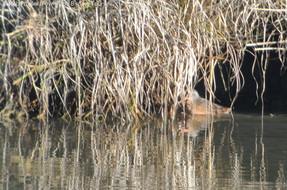 Ron and Jane's lifer Virginia Rail on Klopp Lake. Ron and Jane's lifer Virginia Rail on Klopp Lake. On 17 October I hosted Ron and Jane Miller from Milwaukee, WI for four hours of birding. We spent the whole morning at the Arcata Marsh as Ron had wanted to try and get looks at Virginia Rail and Sora, which he had never seen along with some easy to find species like White-tailed Kite. There were also possibilities of seeing some recently found rarities like Painted Bunting and Brewer's Sparrow in the area. The weather was perfect with clear skies, cool temps in the morning, becoming warmer by the end of the morning and little wind the whole time, making for a very pleasant and productive morning of birding. With a leisurely and relaxed pace we ended up tallying 76 species! 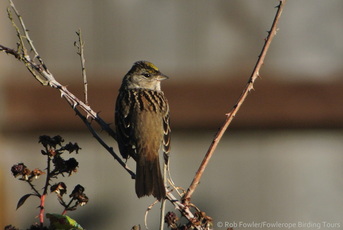 John's lifer Golden-crowned Sparrow. John's lifer Golden-crowned Sparrow. Last Friday I was hired by Florida birder, John Erickson, for some "Power Birding" (John's words). He first contacted me by finding my name on the Redwood Region Audubon website (www.RRAS.org) since I am the field trip coordinator for that organization. John first asked if I knew of anybody that might be willing to bird with him while he was in Humboldt County for a couple of days and I said I did know of some local birders that might be available, and also mentioned that I was a guide. Long-story-short, he hired me for a half day of birding, hoping to see as many lifers possible in five hours. Since John had never been birding on the West Coast he had a lenghty list of potential lifer western birds. The night before I made a list of the his potential lifers we could see along the coastal slope around the north Humboldt Bay region and came up with a list of 45 species! It's always SOOOO fun to be able to potentially help a birder get so many lifers that has never visited the West Coast before.  Terry and Judy enjoying the north jetty. Terry and Judy enjoying the north jetty. Last Friday, 20 September, I had the opportunity to show Judy and Terry (from Chicago, IL) around the north spit of Humboldt Bay for a 1/2 day of birding. We got started around 9:00 a.m. and drove out to the north jetty of Humboldt Bay, one of the best locations in Humboldt County to do seawatches and see the West Coast rocky shorebirds like Black Turnstone, Wandering Tattler, and Surfbird. We also visited some of the famed migrant traps on the north spit of Humboldt Bay in an effort to find landbirds of interest. We arrived at the jetty around 9:40 a.m. and, due to the first major fall storm set to arrive shortly, the ocean swell was pretty big (around 7-9 ft) and the whole jetty and the waters east of it were full of surfers hoping to catch one of the big waves that were coming in. I told Terry and Judy that these were the most surfers I had ever seen at this spot as the whole parking area was full from the 30-40 of them present here! High tide was scheduled around 12:50 and we walked out quickly to reach the tip while taking a couple of minutes to enjoy some SURF SCOTERS, PELAGIC CORMORANTS and our first BLACK TURNSTONE (lifer for Judy) of the morning. Since the tide was coming up most of the rocky shorebirds were already in roost mode and were grouped together at the north end of the jetty. Here we had perfect looks at more BLACK TURNSTONES, Judy's lifer SURFBIRDS and WANDERING TATTLERS. This past Wednesday I had another opportunity to share some of Humboldt Counties' diverse montane birdlife to another out of state birder, New York resident, Doug Happ. Doug was traveling to California to go on some of Debi Shearwater's pelagics and was planning to visit a friend in Fort Bragg in between his 3 scheduled Shearwater trips. He had never birded in Northwestern California before and noted some species on my website and my various web postings that he hadn't seen before so he contacted me and set up a date to take him out and show him some new birds and a new area of California. Like some of my other recent clients from back east he wanted to see species like Sooty Grouse, Red-breasted Sapsucker, White-headed Woodpecker, Hammond's and Pacific-slope Flycatchers, MacGillivray's Warbler, and other "Western Specialties." With these species in mind it was only right to head back up to the Horse and Grouse Mountain area, THE most accessible location for all these species and more. The base of Titlow Hill Road is only 28 miles from the Highway 101/299 intersection and is just a little more than a 1/2 hour drive to get into serious montane birding from the foggy coastal zone.
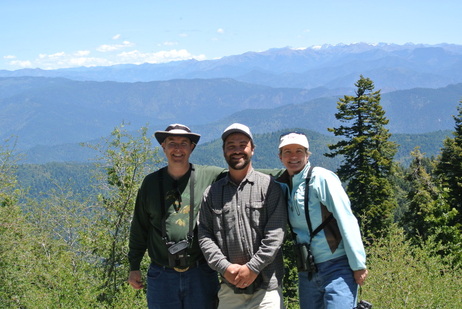 Bill, myself, and Robyn along Route 1 with the Trinity Alps in the background. Bill, myself, and Robyn along Route 1 with the Trinity Alps in the background. This past Sunday, 16 June, I had a full and productive day of birding with Robyn Puffenbarger and Bill Benish from Virginia. We were out for 12 hours and tallied 82 species without even hitting the coastal slope! The day was pleasant with very mild temperatures, mostly clear skies, and little wind. About 8 hours of the day were spent exploring the high country of the Horse to Grouse Mountain areas along Titlow Hill Rd./Forest Service Route 1 and the remaining time was spent birding the Mad River Hatchery near the town of Blue Lake. Highlights of the day were great looks at the following species: MOUNTAIN QUAIL (always hard to see), WHITE-HEADED WOODPECKERS (attending a nest), RED-BREASTED SAPSUCKER, HAMMOND'S, DUSKY, and WILLOW FLYCATCHERS, CASSIN'S VIREO, HERMIT WARBLER, YELLOW-BREASTED CHAT, GREEN-TAILED TOWHEE, and THICK-BILLED FOX SPARROW. LAZULI BUNTING was the abundant bird of the day and was seen at almost every stop we made in the Horse/Grouse mountain area. The rarity of the day was an adult male INDIGO BUNTING (INBU), which may have followed the Puffenbargers from Virginia somehow! ;) (This was the 3rd INBU to be found within the past 2 weeks in Humboldt County and all of them have been adult males!) 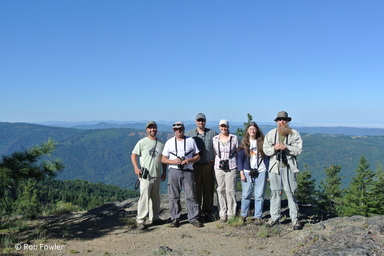 The group. The group. Yesterday, 8 June, I led my annual Horse Mountain field trip for Redwood Region Audubon Society. The Horse Mountain region is the closest high elevation location from the Humboldt Bay Region and only takes about 1/2 hour to 40 minutes for one to reach the area going east on Highway 299. There's a nice mix of habitats up there with serpentine Jeffrey pine forests, some regenerating clearcuts, high elevation meadows, oak woodlands, and at the highest elevations along the route, white fir forests. The actual Horse Mountain is an official "botanical area" due to the coastal Jefferey pine, western white pine, and Port-orford Cedar communities that are found within its' 1,100 acres. With this large diversity of habitats comes a great diversity of bird species. If you want to see montane species like Sooty Grouse, Mountain Quail (both mostly heard only, though). White-headed Woodpecker, Hammond's and Dusky Flycatchers, Mountain Chickadee, Townsend's Solitaire, Hermit Warbler, Green-tailed Towhee, Thick-billed Fox Sparrow, and others, then the Horse Mountain area is THE place to go in Humboldt County for these species. This past Tuesday, 30 April 2013, I had the great opportunity to share some of Northwestern California's birds with some birders from the East Coast, Bruce and Jean Webber from Connecticut. Bruce and Jean had found my website online and were coming to San Francisco to visit their son and during their visit wanted to get away for 3-4 days to visit the Redwoods in Northwestern California and do some birding. They looked at my "Species of Interest" page and came up with a list of species that would be "lifers" for them.
We met a bit after 0700 in the Arcata Marsh Interpretive Center parking lot and made our way out to the Blue Lake area to look for some of their needed birds like: Band-tailed Pigeon, Cassin's Vireo, Vaux's Swift, Pacific-slope Flycatcher, Black-throated Gray Warbler, McGillivray's Warbler, and Lazuli Bunting. We started at the Blue Lake Cottonwoods, one of the best locations in Humboldt County for for neotropical migrants that breed and migrate through, like some of the ones mentioned above. We started off looking at the Mad River opposite of the Cottonwoods and had SPOTTED SANDPIPER fly by and had at least 3 LAZULI BUNTINGS singing on the other side of the river but, despite much scanning, couldn't get any looks at the birds. We then went into the Cottonwoods and worked on deciphering some of the birds singing like our lutescens ORANGE-CROWNED WARBLER and BEWICK'S WREN, before picking up the first "lifer" for Bruce and Jean, CASSIN'S VIREO! A pair of CASSIN'S came down nice and low in response to my pishing and provided really nice and close views at eye level. While enjoying the CASSIN'S we also had some looks at a WARBLING VIREO and heard a migrant WESTERN TANAGER singing a bit to the east. While enjoying the Cassin's I heard a male BLACK-THROATED GRAY WARBLER singing a bit to the west of us and after a bit of work we tracked it down for a couple of decent looks. After enjoying the Black-throated Gray for a bit we continued on, enjoying some other birds along the way with decent looks at some male ALLEN'S and ANNA'S HUMMINGBIRDS, a couple of "singing" male "RED-SHAFTED" FLICKERS, a couple of CHESTNUT-BACKED CHICKADEES, and flushed a male CALIFORNIA QUAIL. |
Archives
October 2014
Categories
All
Blog Roll
|
||||||